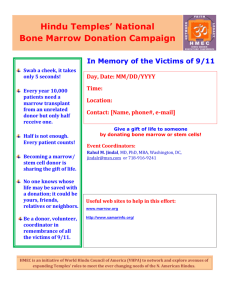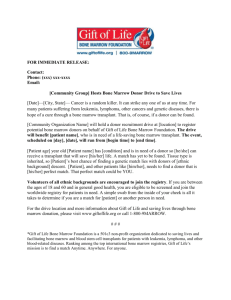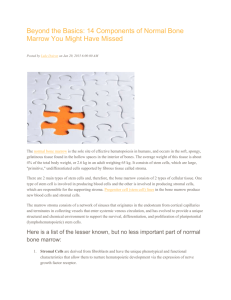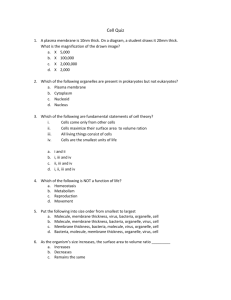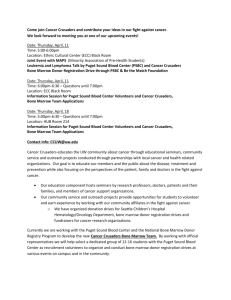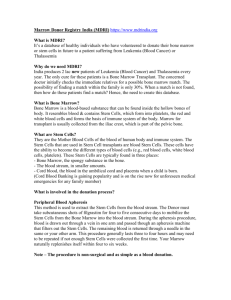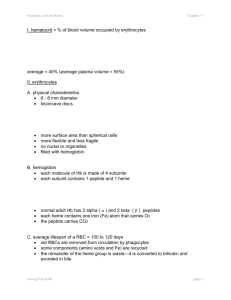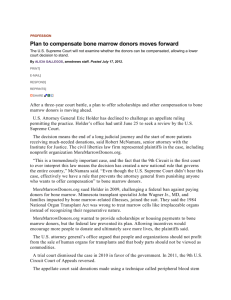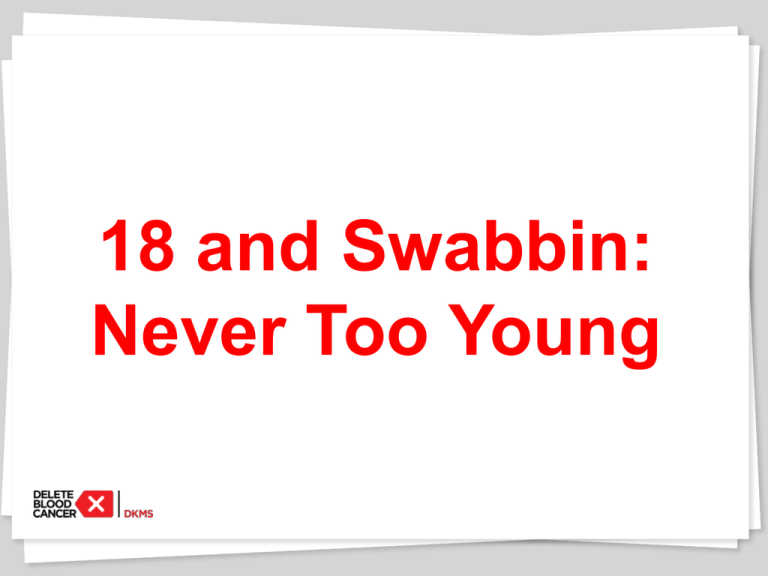
18 and Swabbin:
Never Too Young
The Delete Blood Cancer
Mission
Our mission is our name.
• We work to “Delete Blood Cancer” by inspiring as
many people as possible to register as potential
bone marrow donors and to provide patients with a
second chance at life. We are achieving this by
being innovative in our outreach, empowering in
our appeal, and personally involved in supporting
our patients and donors.
2
• Every 4 minutes,
an American is diagnosed with
blood cancer.
•
Every 10 minutes, it takes a life.
•
Leukemia is leading cause of
death in small children in the US
3
What is Blood Cancer?
A malignancy that attacks the blood, bone marrow, or
lymphatic system. The most commonly known types of
blood cancer are leukemia, lymphoma and multiple
myeloma.
When conventional treatments such as
chemotherapy don’t work, the only hope is a
bone marrow transplant.
4
Only 30% of all patients are able to find a compatible bone marrow
donor in their family
5
When a patient cannot find a
match within their family,
they turn to the
National Bone Marrow Registry
6
6 out of 10 patients can’t find a bone marrow donor on the national
registry.
7
Today’s Agenda
To introduce you to our
18 and Swabbin program
and show you ways that
your entire school, not
just the 18 year olds, can
join the fight against
blood cancer.
8
2 types of donations
When you register, you have the potential of donating either bone
marrow or blood stem cells, depending on the needs of the
patient. Bone marrow is the spongy tissue inside your bones that
produces blood stem cells—the cells in your body that produce
red and white blood cells, as well as platelets. These blood stem
cells also exist in your bloodstream, where they are called
peripheral blood stem cells (PBSC). There are different procedures
for donating marrow and blood stem cells.
Donor Information
2 types of donations:
• Peripheral Blood Stem
Cell (PBSC) collection is a
non-surgical, outpatient
procedure that collects
blood stem cells via the
bloodstream in a
process similar to
donating plasma or
platelets. This method
is used in 75% of the
cases.
• Bone Marrow Donation:
This is a surgical procedure
performed under
anesthesia, so no pain is
experienced during
donation. Marrow cells are
collected from the back of
your pelvic bone using a
syringe. This method is
used in about 25% of cases,
generally when the patient
is a child.
10
Common Questions
How do I get on
the bone marrow
registry?
Doesn’t
donating hurt?
11
To become a bone
marrow donor, you
must be 18-55 years
old, in good general
health, weigh at least
110 pounds, have a
maximum body mass
index of 40, and be
willing to donate to
any patient in need.
Both donation
procedures will result in
some level of
discomfort, but most
donors report that any
pain experienced is
easily eclipsed by the
positive feelings of
knowing they are
possibly saving a life.
12
BHS Delete Blood Cancer Drive
Thursday February 19th
2:00 pm – 8:00 pm
BHS Commons
NHS students will be helping with the drive
13
Building Character…and
Resumes
• Reinforcing the importance of giving back to
the community
• Fulfilling service hours
• Great resume builder
• Delete Blood Cancer provide certificates and
letters of recommendation for students that
go above and beyond
14
Any Questions?
Please share drive
information with family
and friends!
15

